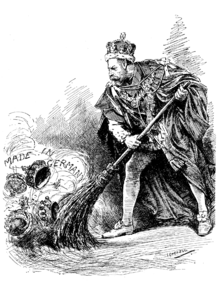Mountbatten-Windsor
Mountbatten-Windsor is the personal surname of some of the descendants of Queen Elizabeth II and Prince Philip, Duke of Edinburgh under a Declaration made in Council in 1960.[1] However, although the declaration specifically applies the name "Mountbatten-Windsor" to male-line descendants of the Queen not holding Royal styles and titles, "Mountbatten-Windsor" has been used by some descendants of the Queen who do hold Royal styles. This is presumably on the basis that the 1960 declaration is argued to confer a "hidden surname" in such cases.[2] For example, each of Prince Andrew, Duke of York and Anne, the Princess Royal, children of the Queen, used the surname "Mountbatten-Windsor" in official marriage registry entries. Likewise, the Duke and Duchess of Cambridge used the name when filing a French lawsuit related to the topless pictures of Catherine published by the French magazine Closer.[3]
Mountbatten-Windsor differs from the official name of the British Royal Family or Royal House, which remains Windsor.[1] The adoption of the Mountbatten-Windsor surname applies only to members of the Royal Family who are descended from the Queen, and not, for example, to her cousins, or descendants of her sister, Princess Margaret.
Mountbatten-Windsor may be considered a cadet branch of the House of Schleswig-Holstein-Sonderburg-Glücksburg, which in turn is a branch of the House of Oldenburg.[4]
History of the Mountbatten and Windsor surnames

The King has done a popular act in abolishing the German titles held by members of His Majesty's family.
Cartoon from Punch magazine Vol. 152, June 27, 1917, noting the UK Royal Family's change of name to Windsor
The Mountbatten surname derives from the German town of Battenberg, in Hesse. Prince Louis of Battenberg Anglicised his surname to Mountbatten (its literal English translation) during the First World War at the request of King George V. When then-Prince Philip of Greece and Denmark, a member of the House of Schleswig-Holstein-Sonderburg-Glücksburg (the royal house of Denmark and Norway and the deposed royal house of Greece) took British citizenship, he used this surname since he descends from the Battenberg family through his mother, Princess Alice of Battenberg.
The name Windsor was adopted by the British branch of the House of Saxe-Coburg and Gotha in 1917.
Users of the surname
The following people make use of, in current practice, or have made use of, the surname Mountbatten-Windsor.[citation needed] They are listed in the order of succession to the Crown.
- The Prince Charles, Prince of Wales and his second wife, Camilla, Duchess of Cornwall
- The Prince Andrew, Duke of York
- The Prince Edward, Earl of Wessex and his wife, Sophie, Countess of Wessex
- James, Viscount Severn (styled Viscount Severn)
- Lady Louise Windsor (simply styled with the name Windsor)
- The Princess Anne, Princess Royal (until her marriage with Mark Phillips in 1973[1] [divorced 1992] when she assumed his surname; her surname has subsequently changed again on the occasion of her marriage with Timothy Laurence in 1992)
None of the above, except arguably the children of the Earl and Countess of Wessex, actually have a surname as part of their legal name, owing to the styles that are used for members of the Royal Family. For example, when the Duke of York was in the Navy, he was referred to as Lieutenant His Royal Highness, The Prince Andrew before he became The Duke of York, and Lieutenant His Royal Highness, The Duke of York afterwards - but not Lieutenant Mountbatten-Windsor. While Mountbatten-Windsor was entered into the marriage register for Prince Andrew and Princess Anne, the Prince of Wales was entered as simply "The Prince Charles Philip Arthur George".
It has been reported in the American press that as a practical day-to-day matter in their active Royal Navy service, both Charles and Andrew were referred to as "Lieutenant Windsor".
Both Princes William and Harry have used "Wales" as a last name during their schooling. Both were known as Officer Cadet Wales at the Sandhurst Military Academy. They wrote the name "Wales" on their socks and underwear for laundering. Princess Beatrice and Princess Eugenie of York both similarly use "York" as a last name.
The Earl of Wessex has styled himself "Edward Wessex" for his television series Crown and Country since acquiring that title upon his marriage. Prior thereto, the show's credits listed him as "Edward Windsor."
However, with the arguable exception of the children of the Earl and Countess of Wessex, all the above persons as holders of Royal styles and titles are strictly speaking thought to have no surname, although it is argued that they carry it latently in their lineage (see above). Persons who would need to bear the hyphenated surname under the 1960 declaration include be any male-line great-grandchildren of the Queen in cadet branches; e.g., the children of any sons of the Duke of York (but also arguably the children of the Earl and Countess of Wessex, since they do not use the styles of Royal Highness and Prince or Princess). Similarly, in the event that any male-line granddaughter of the Queen were to have a child whilst unwed, such a child might have the surname of Mountbatten-Windsor.
During the court case over the 2012 topless photos scandal, William was referred to as "Monsieur William Arthur Philip Louis Mountbatten-Windsor" by the courts of the French Republic.[5]
See also
References
- ^ a b c "The Royal Family name". The British Monarchy. Retrieved 2011-05-05.
- ^ http://www.heraldica.org/topics/britain/TNA/HO_290_72.htm (see, in particular, the article by Edward F. Iwi).
- ^ http://www.independent.co.uk/news/world/europe/william-and-kate-win-legal-battle--but-lose-war-to-keep-topless-photos-under-wraps-8153383.html
- ^ McCartney, Stewart (2012). Popular Errors Explained. New York: Random House. ISBN 1409021890.
- ^ Gripper, Ann (2012-09-18). "Kate Middleton Closer topless pictures - reaction as royals start court fight". Mirror. Retrieved 2012-09-21.
